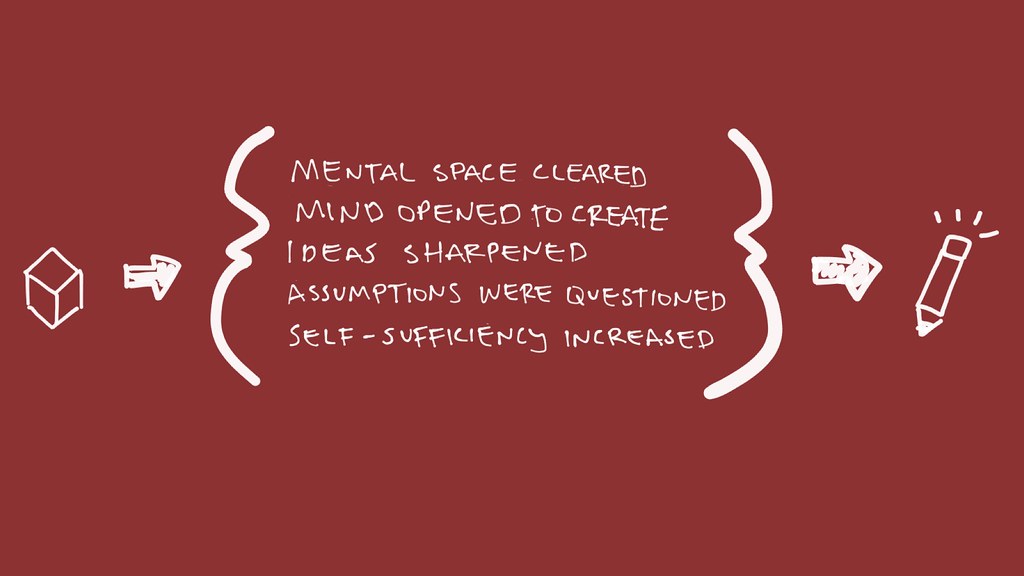How a Minimalist Lifestyle Made Me a Better Designer

Your day-to-day choices unconsciously steer your design process. Whichever habits you break or accept, methods you stick to or question will affect your openness, curiosity and intuition. While many make purposeful changes in either diet, consumption or activities, others do not. It’s a choice. When I chose a minimalist lifestyle, question after question around habits I probably never made knowingly surfaced. I had to edit, let go and move on. It freed my mind and my time to create more while forging a ruthless choice-making mechanism in my design process. Less made me appreciate more.
Let’s get one thing straight. Going down the minimalism route was not voluntary at first. A need to clean after moving to my boyfriend’s small apartment threw me in the minimalist stream with no floaties attached. But instead of swimming back to shore, I went further. It snowballed into other improvements in the kitchen, how I packed for travel and the beauty care products I used. One change can lead to so many. I noticed at this time my design approach shifted. It became quicker while I had more space to create. Win-wins that anyone can achieve.
The first thing minimalism did was clear my mental and physical space
It swooped over my busy life like an arm over a desk of paper mountains. Even before this experiment escalated to all areas of my life, I always said, “organization is laziness for the future”. Minimalism takes this to the nth degree. After the days of paper purging, clothes tossing and shoe shoeing there’s a lack of items to manage. The future feels lighter without the need to keep re-organizing. And those supplies I thought one day would come of use, like for some painting or long-dreamed art project? Gone and the guilt went too. Physical clutter creates unnoticed deposits on mental stamina tha no ones needs.
Without so many items to tend to, my mind is more open to create
When I go home, there are a couple of clothes piles there or dishes to be put away. Minimalism is not bippity-boppity-boop Cinderella magic. But it’s seconds not minutes, or even hours, to resolve. So when I go home, it’s about … Cooking. Reading. Writing. Making little illustrations. Learning Dutch. Planning for holidays. Dreaming. Baking. Skyping with my family. Considering business ideas. Rebuilding my website. Doing, being and not cleaning. I have time to enjoy my possessions without being possessed by them.
My eye for unique products and ideas sharpened
Not so many products get past this front door anymore. Even when I go to IKEA, now I leave with less than what’s on my shopping list. Before purchasing any product or wardrobe item I ask myself: does something else do the same job? I am buying this because I just want something? How will I feel tomorrow? Is it an acceptable price/quality ratio? Scrutinizing my own purchases is a warm up for making better, and more brutal, design choices. My ability to edit quickened and my fear of letting go dissipated. There will anyway be new things to buy and new ideas to develop; I am not afraid anymore to move on.
I question my assumptions in design more than ever before
I’ve developed this odd split personality. When beginning to working through a concept, I purposefully try to throw out what I know. Be a fresh-out-of-design-school designer again. This came from re-evaluating my lifestyle and those little details I took for granted. Questioning my wardrobe made me question my beauty routine. Then how I shopped for groceries. My shampoo. My coffee budget. My document keeping. I looked from the outside in and could spot the inefficiencies better, and with less emotion. Sure, life would have been better if I did this earlier, but look at all I’ve learned!
My feeling of self-sufficiency re-surfaced and strenghtened
We kind of got soft by 2016. Conveniences, brands and specialists can solve most of our problems. But even the most focused designer needs a wide range of tools. By becoming more self-sufficient in my minimalist lifestyle, I took responsibility. This gave me confidence to approach new problems, even if I did not know completely how they should be done. As a minimalist, I’ve made my own skin care products from everyday substances to reduce bottles bought, for example. It just took a little research. Somewhere down the corporate line, this muscle weakened. Changing my lifestyle reversed that process.
Changing your lifestyle makes you think and question yourself. It can be very confronting, as I found. But there is not a moment I regret living with less. Minimalism cut the noise and amplified the worthwhile people, experiences and products. I appreciate good design more than ever because I can understand its unique view point better. When I started my new lifestyle, my imagination would have never wrapped itself around how one change can lead to a new design approach.